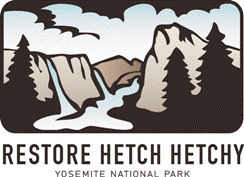The following column was written by The Rev. John Saville, rector of St. John's Episcopal Church in Corona, CA. It was originally published by the
Press-Enterprise (Riverside and San Bernardino counties).
On September 13, Rev. Seville will join
Muir's March, Restore Hetch Hetchy's effort to "Follow in the footsteps of John Muir and help raise awareness and funds for the fight to restore Hetch Hetchy Valley."
Restore spectacular Hetch Hetchy Valley for future generations
By JOHN SAVILLE
Imagine arriving at Yosemite National Park on your next vacation and finding its famous valley has become a reservoir. This is what happened in 1923 to the park's nearby Hetch Hetchy Valley with the completion of the O'Shaughnessy Dam.
Conservationist John Muir, who described the valley as "one of nature's rarest and most precious mountain temples," lost the battle to save this Sierra landmark, described at the time as a "twin" of Yosemite Valley. In recent years, however, a new battle has begun to right a wrong that literally flooded a natural treasure for the water and power needs of the San Francisco Bay Area.
A group called "Restore Hetch Hetchy" is putting the spotlight on the sad results of one of the first great environmental battles of the 20th century.
 Those who love -- and find a refuge in -- nature should join the fight to rehabilitate Hetch Hetchy, Yosemite's "twin."
Those who love -- and find a refuge in -- nature should join the fight to rehabilitate Hetch Hetchy, Yosemite's "twin." The group's 2005 feasibility study, "Finding the Way Back to Hetch Hetchy," reports that with the engineering and technology available today, a win/win solution is possible. This confirmed a 1988 preliminary study requested by President Ronald Reagan's former interior secretary, Donald Hodel. San Francisco's water and power needs can be met without this reservoir and the valley can be brought back to life.
The process of allowing nature to heal itself will take decades. Many of us will not live to see the full results, but we have the opportunity to return a gift for future generations.
During these tough times some may not consider the restoration of Hetch Hetchy a priority. But for all who love nature and find in it a refuge and healing place, restoring a valley with spectacular waterfalls is a worthwhile investment. Furthermore, the restoration would provide a laboratory of learning for engineers and scientists from all over the world.
As long as the government is passing out billions to stimulate the economy, why not use some of those billions to create jobs that will restore, preserve and protect our irreplaceable natural resources? Beyond federal funding, private funds would be sought.
For many, this is a faith issue. It is about being good stewards of God's creation. My father introduced me to the wonders of the national parks through his poetry and sermons. He often quoted Muir, who said, "Dam Hetch Hetchy! As well dam for water-tanks the people's cathedrals and churches, for no holier temple has ever been consecrated by the heart of man."
In the August issue of Sunset magazine, documentarian Ken Burns says, "as owners (of national parks), we ought to just go every once in a while, visit our property, make sure it is being well taken care of..." We now have an opportunity to do more than that. We have an opportunity to tear down this dam and enable our children to watch it grow back to its natural glory.
We have an opportunity to participate in one of the first great environmental battles of the 21st century. We have an opportunity to "right a wrong."
On Sept. 13, I will begin a 45-mile, seven-day hike that will end at the dam to bring awareness and raise funds for the effort to restore Hetch Hetchy. For more information, visit www.restore hetchhetchy.org







